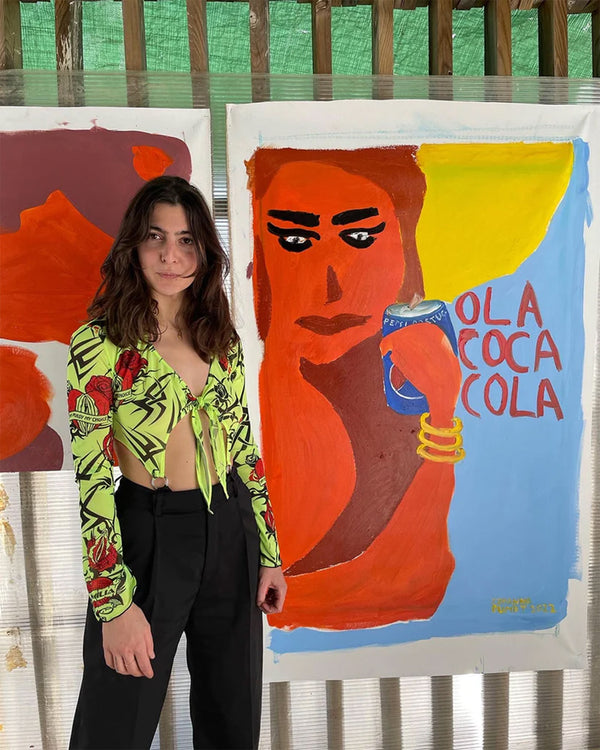ALEXANDER
WERTHEIM
Weaving
Colours
20 July 2023
»The relationship between planning and spontaneity is one of the themes of my paintings. I think the works become good when you mess with their plan a bit.«
»The relationship between planning and spontaneity is one of the themes of my paintings. I think the works become good when you mess with their plan a bit.«
We visited Alexander Wertheim at his studio in Friedrichshain, Berlin, to discuss the ideas behind his first exhibition at KÖNIG GALERIE. The interview is accompanied by pictures showing the process of preparation to the exhibition and his meticulous search for color combinations.

Alexander Wertheim in his studio, Berlin, 2023
König Galerie: We are excited to hear more about your upcoming exhibition. What is the idea behind it?
Alexander Wertheim: The exhibition features a variation of my paintings in which the horizontal and vertical strokes appear as separate entities and intertwine, much like in nature, where all sorts of things also rise vertically, only to be drenched in horizontal gradients of color. The series is inspired by sunsets.
KG: What will the exhibition look like? What kind of works can we see there?
AW: On the outside wall, there are studies on paper that were created during the process of preparing the exhibition. Inside the chapel, there will be works on canvas. The paintings show variations on three pictorial themes that I developed over the course of this summer. Each theme is based on a basic tone, such as red, blue, and green.

KG: Is there a thematic guideline for your work? AW: Something that interests me about the work is the relationship between intuition and rationality. I align my sometimes quite spontaneous painterly decisions with a grid system that is oriented to the rectangular dimensions of the picture support. It puts them into a comprehensible structure in which everything reacts with each other. I like the tension that is created between the overall image and its individual parts, as if they were competing with each other. AW: The first compositional ideas arise in my mind or on the smartphone using the drawing pen in the Notes app. For example, a red image with green and blue strokes over it. With such a plan, I enter the studio and try to implement it. Especially for the series of sunset paintings, I use nuanced tones such as turquoise and lilac. Pastel colors also play a big role in my work. They are less likely to be suspected of being expressive, which I find pleasant. KG: Do you plan your paintings in advance, or do they develop more intuitively? AW: There is a lot of planning on paper, in different formats. On one hand, it brings structure to my working process, on the other hand, the plans change constantly. Sometimes in the course of time, I come back to the initial idea. I can trace these developments through the chronological stacks of paper that I keep in my studio. The relationship between planning and spontaneity is one of the themes of my paintings. I think the works become good when you mess with their plan a bit.
KG: Can you tell us more about how you developed your style? AW: During my time at the art academy, I was interested in decoration and everything that people create to please each other visually. I painted color fields, casino carpets, shower curtains, magazine covers, stock photos, and art deco vases, all in search of a surprising, decorative image. In 2018, I became interested in weaving patterns such as plaid. I liked the alternating fields of colors, and their 90-degree structure made a lot of sense to me. I started to compose patterns and painted them on canvas with miniature brushes. At some point, I had the idea that by drawing horizontal and vertical lines onto the canvas, I could weave my own pictures, but in a human, imperfect, emotional, and silly way. In the beginning, I used brushes, but then switched to spray cans as they allowed me to paint longer continuous lines. Although I never had a relationship with spray paint, I started to appreciate the medium for its directness. Nothing needs to be prepared; you can just grab some cans and start a composition. KG: When you speak about your works you often use musical metaphors. What is your relationship to music? Do you listen to music when you paint?
KG: How do you create compositions? What criteria do you use to select your colours?

 KG: Where do you get your inspiration?
KG: Where do you get your inspiration?
AW: I’m inspired by pillowcases, tablecloths, streamers.
AW: I used to do music as a child and teenager and there are certain analogies between music and my paintings, such as that of melody, which I frequently explore. The sunset paintings are composed in two voices: there is a melody playing in each of the horizontal and vertical orders. I like to think of each spray-painted line as of a tone that runs through the painting.
© All images König Galerie




